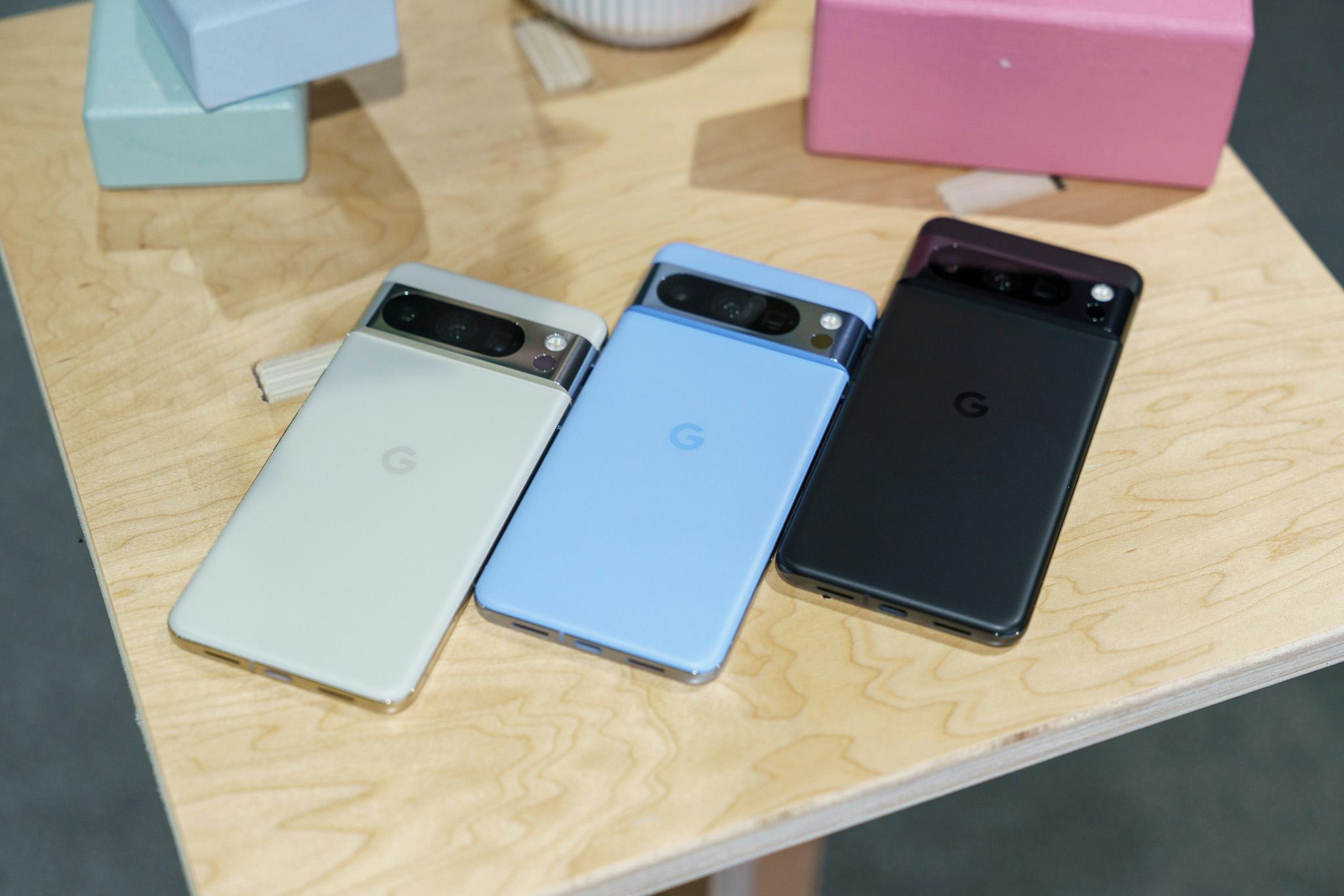
It’s October aka “Techtober,” which means Google is releasing new Pixel devices. Starting October 12, Google’s Pixel lineup will include the new Pixel 8 and 8 Pro smartphones running Android 14, and the Pixel Watch 2 (more details here).
There are no big surprises on the Pixel 8 and 8 Pro. They build off the industrial design established by the Pixel 6 and 6 Pro, with refined hardware details like rounder corners and a unified cutout for the three cameras in the Pixel 8 Pro.
Google’s thrown in a more powerful Tensor G3 chip. The cameras take better low-light photos and there are a handful of new AI-powered features like “Best Take” which combines the best parts of a series of photos into one really good picture, and manual controls (only on the Pixel 8 Pro). The Pixel 8 Pro also has an exclusive temperature sensor... for measuring how hot or cold objects are.
The Pixel 8 and 8 Pro also are more expensive than the Pixel 7 and 7 Pro, starting at $100 more for each — $699 for the Pixel 8 and $999 for the Pixel 8 Pro.
We’ve spent a few minutes with Google’s new phones and have some first impressions.
Pixel 8 Versus Pixel 8 Pro

Because we’re all geeks here at Inverse, below are the tech specs for the Pixel 8 and 8 Pro. As you can see, the differences between the two boil down to “small” and “big” with the Pixel 8 Pro having slightly more advanced features. It has a bigger, brighter, and higher-resolution display, a larger battery, more RAM and additional storage options, and a 48-megapixel ultra-wide and 48-megapixel telephoto cameras.
Pixel 8 Tech Specs
- Display: 6.2 inches (2,400 x 1,080) 120Hz OLED @ 1,400 nits (HDR) and 2,000 nits (peak brightness)
- Battery: 4,575 mAh
- Chipset: Tensor G3
- RAM: 8GB LPDDR5X
- Storage: 128GB / 256GB UFS 3.1
- Rear cameras: 50-megapixel f/1.68 main + 12-megapixel f/2.2 ultrawide with autofocus
- Selfie camera: 10.5-megapixel f/2.2 selfie
- Software: Android 14
- Biometrics: In-display fingerprint reader and Face Unlock
- Colors: Hazel, Obsidian, and Rose
Pixel 8 Pro Tech Specs
- Display: 6.7 inches (2,992 x 1,344) 120Hz OLED @ 1,600 nits (HDR) and 2,400 nits (peak brightness)
- Battery: 5,050 mAh
- Chipset: Tensor G3
- RAM: 12GB LPDDR5
- Storage: 128GB / 256GB / 512GB / 1TB UFS 3.1
- Rear cameras: 50-megapixel f/1.68 main + 48-megapixel f/1.95 ultrawide with autofocus + 48-megapixel f/2.8 telephoto
- Selfie camera: 10.5-megapixel f/2.2 selfie with autofocus
- Software: Android 14
- Biometrics: In-display fingerprint reader and Face Unlock
- Colors: Bay, Obsidian, and Porcelain
First Impressions

As I said earlier, the Pixel 8 and 8 Pro are pretty familiar — they look and feel like Pixels. This is good for branding, maybe not so great if you’re trying to impress your friends with the latest shiny gadget.
The Pixel 8 comes in glossy glass finishes and the Pixel 8 Pro in matte glass (a first on a “pro” Pixel), which is more resistant to fingerprints. The colors are fine — Hazel, Obsidian, and Rose for the Pixel 8 and Bay, Obsidian, and Porcelain for the Pixel 8 Pro — if not a little dull in my opinion. At least the “Bay” blue is more blue than the blue iPhone 15. Seems like 2023 is the year of really boring phone colors.
Look closely and you’ll see two things on the Pixel 8 Pro. The first is the unified cutout for the three rear cameras and the second is the temperature sensor below the LED flash. This temperature sensor works like a thermometer — point it at objects and you’ll get a temperature readout on the screen. The app for it has various presets (i.e. “food & organic” or “beverages & water” or “walls & windows”), but you can stick to the default. I tried it on a glass of water and my forehead (didn’t have a fever!) and it worked. Google says it should be accurate compared to a thermometer; I’ll have to test that myself.


Google says it’s improved low-light shooting on all of the rear cameras. While I wasn’t able to test that, it should be the case since the sensors all come with larger apertures (lower f-stop numbers) which collect more light. The only camera feature I was able to try out was the new “macro focus” mode. Other phones have had macro modes for a while and now the Pixel 8s have it, too. I took a macro shot of flowers from a few centimeters away and the details looked solid even without a lot of light (something you need to get good macro pics). I did get to see the “Pro Controls” mode on the Pixel 8 Pro; it’s similar to the manual control modes on other Android phones where you can adjust camera settings such as exposure, ISO, shutter speed, etc.


As always, the real appeal to the Pixel 8 and 8 Pro are the AI features that other phones don’t have. There are a few new ones that jumped out to me. For example, in the Recorder app, you can get summaries of transcriptions. (Handy for a journalist like myself!) Another feature called “Audio Magic Eraser” (inside of Google Photos) can erase distracting background noise, voices, and sounds.


“Best Take,” as mentioned earlier, combines a series of shots into one single “best shot.” I saw an example of four people sitting at a table, each looking at the camera in different shots, and the Pixel 8 was able to basically create one “best” photo where they were all looking and smiling at the camera. It’s cool, but also kinda freaky. As my colleague James Pero wrote last year: Pixel cameras aren’t capturing reality anymore, they’re creating a new one — the one that you want to remember, even if it didn’t necessarily happen.
And coming soon is “Video Boost” which can convert dark videos into visible HDR+ ones after the original file is processed in the cloud. The Video Boost process can take “a few hours” I’m told, but it might well be worth it.
Just like iPhones or Samsung Galaxies, the Pixel 8 and 8 Pro don’t have any groundbreaking features. They’re better versions of last year’s phones. Boring perhaps, but with seven years of OS, security, and “Feature Drop” updates, Google at least seems confident they can go the distance in the long run.









